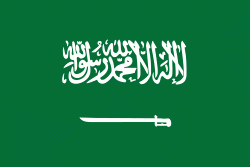Al Wajh (Al Wajh)
Al Wajh (الوجه), also written Al Wejh, is a coastal city in north-western Saudi Arabia, situated on the coast of the Red Sea. The city is located in the Tabuk Province. It is one of the largest cities in Tabuk region, with a population of 50,000 as of 2013.
Al Wajh played a pivotal role during the Arab Revolt in World War I. In 1917, Al Wajh was taken by Prince Faisal's forces and used as a base of operations for a series of attacks on the Hejaz Railway. (See HMS Anne for the British side of that operation).
Al Wajh is a comparatively big city, inhabited mainly by citizens from Al Balawi, Bedaiwi-Alali, Al Huety and Al Johani tribes. Fishing is a primary activity of the city's residents and the port is the central location where this occurs - the Al Wajh port used to be one of the main shipping centres in the region 50 years ago.
The town is served by the Al Wajh Domestic Airport and has close links with the city of Tabuk, with a road connecting the two locations.
Al Wajh played a pivotal role during the Arab Revolt in World War I. In 1917, Al Wajh was taken by Prince Faisal's forces and used as a base of operations for a series of attacks on the Hejaz Railway. (See HMS Anne for the British side of that operation).
Al Wajh is a comparatively big city, inhabited mainly by citizens from Al Balawi, Bedaiwi-Alali, Al Huety and Al Johani tribes. Fishing is a primary activity of the city's residents and the port is the central location where this occurs - the Al Wajh port used to be one of the main shipping centres in the region 50 years ago.
The town is served by the Al Wajh Domestic Airport and has close links with the city of Tabuk, with a road connecting the two locations.
Map - Al Wajh (Al Wajh)
Map
Country - Saudi_Arabia
 |
 |
| Flag of Saudi Arabia | |
Pre-Islamic Arabia, the territory that constitutes modern-day Saudi Arabia, was the site of several ancient cultures and civilizations; the prehistory of Saudi Arabia shows some of the earliest traces of human activity in the world. The world's second-largest religion, Islam, emerged in what is now Saudi Arabia. In the early 7th century, the Islamic prophet Muhammad united the population of Arabian Peninsula and created a single Islamic religious polity. Following his death in 632, his followers rapidly expanded the territory under Muslim rule beyond Arabia, conquering huge and unprecedented swathes of territory (from the Iberian Peninsula in the west to parts of Central and South Asia in the east) in a matter of decades. Arab dynasties originating from modern-day Saudi Arabia founded the Rashidun (632–661), Umayyad (661–750), Abbasid (750–1517), and Fatimid (909–1171) caliphates, as well as numerous other dynasties in Asia, Africa, and Europe.
Currency / Language
| ISO | Currency | Symbol | Significant figures |
|---|---|---|---|
| SAR | Saudi riyal | رس | 2 |
| ISO | Language |
|---|---|
| AR | Arabic language |















